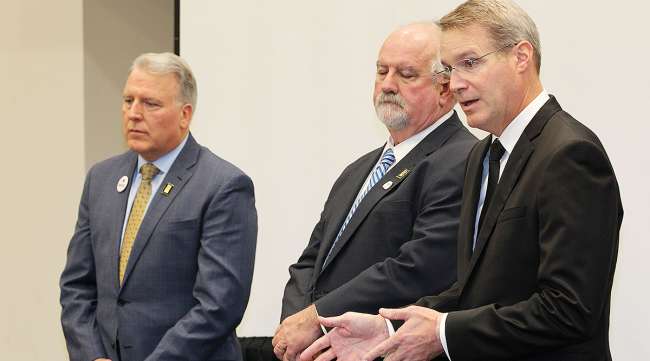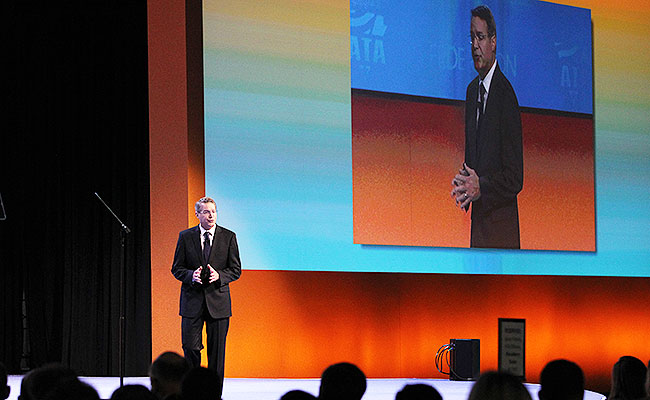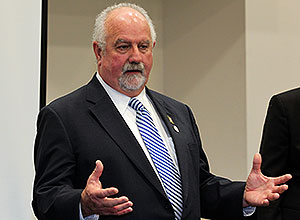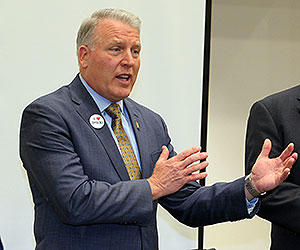Managing Editor, Features and Multimedia
ATA Emerges From MCE Focused on Drivers, Infrastructure

AUSTIN, Texas — While enjoying the benefits of a booming economy and abundant freight to haul, trucking leaders took aim at some of the more persistent challenges that hold the industry back, even in this favorable business environment.
American Trucking Associations charted out its strategies to bolster the industry’s workforce and push for upgrades to the nation’s highway infrastructure here at the federation’s 2018 Management Conference & Exhibition.
Proposed changes to federal hours-of-service rules to give drivers added flexibility was another major topic of discussion at MCE, which brought nearly 2,800 attendees to the Austin Convention Center.
On the labor front, the hot freight market and low national unemployment rate have made it even more difficult for fleets to hire and retain enough workers.
“With a strong economy, our industry’s challenges just got bigger. The chronic driver and technician shortage is now top-fold, national news,” ATA President Chris Spear said during his Oct. 29 industry address.

ATA President Chris Spear delivers his state of the industry address Oct. 29. (John Sommers II for Transport Topics)
For a second straight year, the driver shortage ranked No. 1 on the American Transportation Research Institute’s list of critical issues facing the trucking industry.
As one element of its strategy to address the driver shortage, ATA continues to advocate for the DRIVE-Safe Act, which would create a path for 18- to 20-year-olds to drive commercial trucks across state lines.
ATA also is looking at ways to make it easier for the industry to hire military veterans and bring more urban talent into the trucking industry, with an emphasis on minorities and women, Spear said.
He promoted trucking as an attractive career opportunity for many workers.
“With an average driver salary of $55,000, a figure that continues to climb, ours is an immediate, barrier-free path to the middle class — without having to obtain all the debt that comes with a college degree,” Spear said.

Pottle by John Sommers II for Transport Topics
At MCE’s closing press conference on Oct. 30, newly-elected ATA Chairman Barry Pottle said the industry must take steps to address frequent sources of driver frustration, including the scarcity of truck parking and long waiting times at shippers’ facilities.
“I think it’s very important that we fix some of these things,” said Pottle, who is CEO of Pottle’s Transportation in Bangor, Maine.
At the same time, the industry must continue its work to enhance the public image of the truck driving profession so young people begin to think about it as a first career, rather than a second or third career, he said.

Manning by John Sommers II for Transport Topics
Outgoing ATA Chairman Dave Manning, who is president of TCW Inc. in Nashville, Tenn., said the truck driver shortage has existed for a number of years, “but it was masked by slow growth.”
As the economy has accelerated, so has the urgency to hire drivers, he said.
“We’re all turning down freight because we don’t have the drivers,” Manning said. “So it’s not just replacing drivers; it’s trying to grow our businesses at a time when there’s an opportunity to do that.”
Highway infrastructure funding was another top priority at MCE.
Spear said he believes 2019 will be the year that Congress takes up this debate, regardless of which political party wins control of the U.S. Senate and House of Representatives in the midterm elections.
“Roads and bridges aren’t partisan,” he said at the closing press conference. “And I think there’s general agreement that this is a national priority.”
He also said President Donald Trump could use the looming insolvency of the Highway Trust Fund in 2020 as “incredible leverage” to pressure action on this issue.
The industry loses 1.2 billion hours of productivity annually due to traffic congestion on the national highway system, according to ATRI’s most recent report on the cost of congestion.
Meanwhile, ATA also is eyeing potential changes to HOS rules following the industry’s adoption of federally mandated electronic logging devices.
“Now is the time for the [Federal Motor Carrier Safety Administration] to make sensible changes to the federal HOS regulations,” Spear said. “ELDs make more data available to the industry than before, enabling ATA to advocate common-sense improvements to these rules and allow us to tighten the reins on detention time.”
At a heavily attended session earlier in the conference, FMCSA Administrator Ray Martinez addressed HOS and provided updates on other regulatory issues. He said the ELD rollout has reduced HOS violations while also creating an opportunity to reexamine the underlying HOS rules and consider if adjustments are needed.
Martinez also expressed concerns about a “patchwork” of state regulations in reference to California’s meal-and-rest break requirements, which differ from federal rules. ATA has petitioned FMCSA to determine that California’s rules are pre-empted by federal law.
Another featured speaker at MCE was Tennessee Gov. Bill Haslam, who advised attendees to support political candidates who promote job creation and workforce development.
Throughout the conference, truck manufacturers, component suppliers and technology vendors showcased their latest products in the MCE exhibit hall, providing fleets an array of options to improve safety, fuel economy, driver recruiting and operational efficiency.


